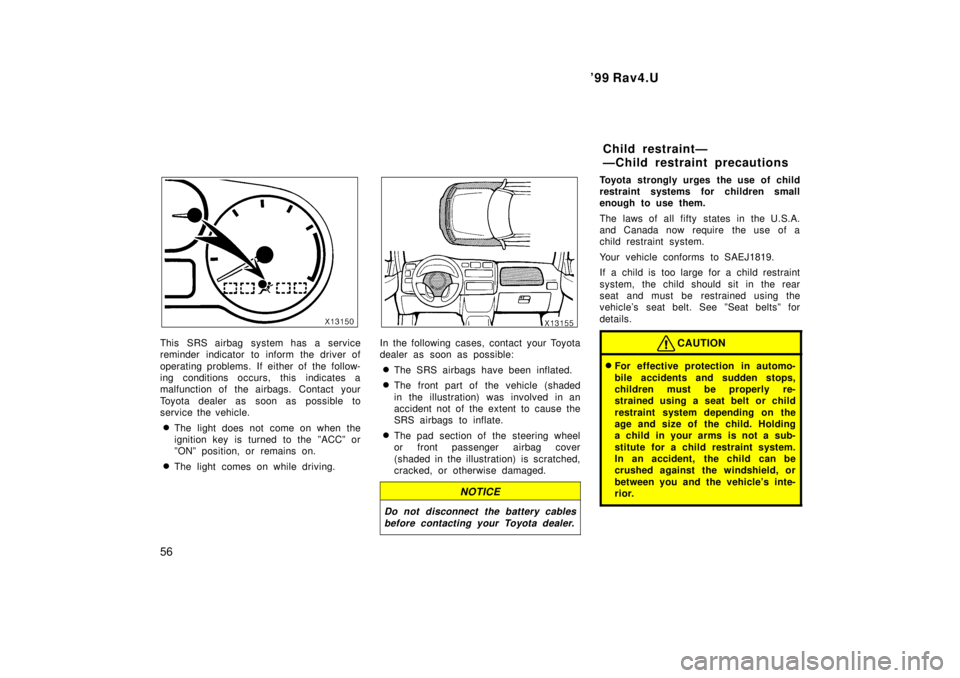1999 TOYOTA RAV4 air condition
[x] Cancel search: air conditionPage 3 of 226

'99 Rav4.U3
1. Instrument panel light control knob
2. Headlight and turn signal switch
3. Wiper and washer switches
4. Clock
5. Center differential lock button or driving
pattern selector button
6. Air conditioning controls
7. Emergency flasher switch
8. Rear window defogger switch
9. Car audio
10. Cigarette lighter
11. Ignition switch
12. Cruise control switch
13. Tilt steering lock release lever
14. Power door lock switch (without power windows)
15. Power rear view mirror control switch
Page 49 of 226

'99 Rav4.U49
This front seat belt pretensioner system
has a service reminder indicator to inform
the driver of operating problems. If either
of the following conditions occurs, this
indicates a malfunction of the airbags or
pretensioners. Contact your Toyota dealer
as soon as possible to service the
vehicle.� The light does not come on when the
ignition key is turned to the ºACCº or
ºONº position, or remains on.
� The light comes on or flashes while
driving.
� If either front seat belt does not retract
or can not be pulled out due to a
malfunction or activation of the preten-
sioner. �
The front seat belt pretensioner assem-
bly or surrounding area has been dam-aged.
� The front part of the vehicle (shaded
in the illustration) was involved in an
accident not of the extent to cause the
seat belt pretensioners to operate.
� The front seat belt pretensioner assem-
bly is scratched, cracked, or otherwise
damaged.The SRS (Supplemental Restraint Sys-
tem) airbags are designed to provide
further protection for the driver and
front passenger when added to the pri-
mary protection provided by the seat
belts.
In response to a severe frontal impact,
the SRS airbags work together with the
seat belts to help prevent or reduce injury
by inflating, in order to decrease the likeli-
hood of the driver 's or front passenger 's
head or chest directly hitting the steering
wheel or dashboard. The passenger airbag
is activated even with no passenger in the
front seat.
Be sure to wear your seat belt.
SRS driver and front
passenger airbags
Page 56 of 226

'99 Rav4.U
56
This SRS airbag system has a service
reminder indicator to inform the driver of
operating problems. If either of the follow-
ing conditions occurs, this indicates a
malfunction of the airbags. Contact your
Toyota dealer as soon as possible to
service the vehicle. � The light does not come on when the
ignition key is turned to the ºACCº or
ºONº position, or remains on.
� The light comes on while driving.In the following cases, contact your Toyota
dealer as soon as possible:
� The SRS airbags have been inflated.
� The front part of the vehicle (shaded
in the illustration) was involved in an
accident not of the extent to cause the
SRS airbags to inflate.
� The pad section of the steering wheel
or front passenger airbag cover
(shaded in the illustration) is scratched,
cracked, or otherwise damaged.
NOTICE
Do not disconnect the battery cables
before contacting your Toyota dealer.
Toyota strongly urges the use of child
restraint systems for children small
enough to use them.
The laws of all fifty states in the U.S.A.
and Canada now require the use of a
child restraint system.
Your vehicle conforms to SAEJ1819.
If a child is too large for a child restraint
system, the child s hould sit in the rear
seat and must be restrained using the
vehicle's seat belt. See ºSeat beltsº for
details.
CAUTION
� For effective protection in automo-
bile accidents and sudden stops,
children must be properly re-
strained using a seat belt or child
restraint system depending on the
age and size of the child. Holding
a child in your arms is not a sub-
stitute for a child restraint system.
In an accident, the child can be
crushed against the windshield, or
between you and the vehicle's inte-
rior.
Child restraintÐ
ÐChild restraint precautions
Page 84 of 226

'99 Rav4.U
84
The gauge indicates the engine coolant
temperature when the ignition switch is
on. The engine operating temperature
will vary with changes in weather and
engine load.
If the needle moves into the red zone,
your engine is too hot. If your vehicle
overheats, stop your vehicle and allow the
engine to cool. Your vehicle may overheat during severe
operating conditions, such as:
� Driving up a long hill on a hot day.
� Reducing speed or stopping after high
speed driving.
� Idling for a long period with the air
conditioning on in stop- and- go traffic.
� Towing a trailer.
NOTICE
�Do not remove the thermostat in
the engine cooling system as thismay cause the engine to overheat.The thermostat is designed to con-
trol the flow of coolant to keep thetemperature of the engine within
the specified operating range.
�Do not continue driving with anoverheated engine. See ºIf your ve-hicle overheatsº in Part 4.
Tachometer
The tachometer indicates engine speed
in thousands of rpm
( revolutions per
minute). Use it while driving to select
correct shift points and to prevent en-
gine lugging and overrevving.
Driving with the engine running too fast
causes excessive engine wear and poor
fuel economy. Remember, in most cases
the slower the engine speed, the greater
the fuel economy.
NOTICE
Do not let the indicator needle get
into the red zone. This may causesevere engine damage.
Engine coolant temperature
gauge
Page 87 of 226

'99 Rav4.U87
CAUTION
It is dangerous to continue driving
normally when the brake fluid level is
low.
If the brake fluid level is correct...
Have the warning system checked by your
Toyota dealer.
(b) Seat Belt Reminder Light and Buzz-er
The light and buzzer remind you to buckle
up the driver 's seat belt.
Once the ignition key is turned to ºONº or
ºSTARTº, the reminder light flashes and
buzzer sounds if the driver 's seat belt is
not pulled out. Unless the driver starts to
pull the shoulder belt out of the retractor,
the light keeps flashing and the buzzer
stops after about 4 to 8 seconds.
(c) Discharge Warning Light
This light warns that the battery is being
discharged.
If it comes on while you are driving, there
is a problem somewhere in the charging
system. The engine ignition will continue to oper-
ate, however, until the battery is dis-
charged. Turn off the air conditioning,
blower, radio,etc., and drive directly to the
nearest Toyota dealer or repair shop.
NOTICE
Do not continue driving if the engine
drive belt is broken or loose.
(d) Low Oil Pressure Warning Light
This light warns that the engine oil pres-
sure is too low.
If it flickers or stays on while you are
driving, pull off the road to a safe place
and stop the engine immediately. Call a
Toyota dealer or qualified repair shop for
assistance.
The light may occasionally flicker when
the engine is idling or it may come on
briefly after a hard stop. There is no
cause for concern if it then goes out when
the engine is accelerated slightly.
The light may come on when the oil level
is extremely low. It is not designed to
indicate low oil level, and the oil level
must be checked using the level dipstick.
NOTICE
Do not drive the vehicle with thewarning light onÐeven for one block.It may ruin the engine.
(e) Malfunction Indicator Lamp
This lamp comes on in the following
cases.
a. The fuel tank is completely empty. (See
ºFuel gaugeº in Chapter 1- 5 for instruc-
tions.)
b. The fuel tank cap is not tightened se-
curely. (See ºFuel tank capº in Chapter
1- 2 for instructions.)
c. There is a problem somewhere in your
engine or automatic transmission electrical
system.
If it comes on while you are driving in
case c, have your vehicle checked/re-
paired by your Toyota dealer as soon as
possible.
Page 88 of 226

'99 Rav4.U
88
(f) Low Fuel Level Warning Light
This light comes on when the fuel level
in the tank becomes nearly empty. Fill up
the tank as soon as possible.
On inclines or curves, due to the move-
ment of fuel in the tank, the low fuel level
warning light may come on earlier than
usual.
(g) ºABSº Warning Light
This light warns that there is a problem
somewhere in your anti- lock brake sys-
tem.
If the light comes on while you are driv-
ing, have your vehicle checked by your
Toyota dealer as soon as possible.
The light will come on when the ignition
key is turned to the ºONº position. After
a few seconds, the light will go off.
When the ºABSº warning light is on (and
the brake system warning light is off), the
brake system operates conventionally but
anti- lock brake system is not assisting
brake performance so that the wheels can
lock- up during sudden braking or braking
on slippery road surfaces.
(h) Open Door Warning Light
This light remains on until all the doors,
back door (hardtop) and tailgate (soft- top)
are completely closed.
(i) Automatic Transmission Fluid Tem-
perature Warning Light (four- wheel
drive models)
This light warns that the automatic trans-
mission fluid temperature is too high.
If this light comes on while you are driv-
ing, slow down and pull off the road. Stop
the vehicle at a safe place and put the
selector lever in ºPº. With the engine id-
ling, wait until the light goes off. If the
light goes off, you can start the vehicle
again. If the light does not go off, call a
Toyota dealer or qualified repair shop for
assistance.
NOTICE
Continued driving with the warning light on may damage the automatictransmission.
(j) SRS Airbag Warning Light
This light will come on when the igni-
tion key is turned to the ºACCº or
ºONº position. After about 6 seconds,
the light will go off. This means the
system of the airbag and front seat belt
pretensioners are operating properly.
The warning light system monitors the air-
bag sensor assembly, front airbag sen-
sors, seat belt pretensioner assemblies,
inflators, warning light, interconnecting wir-
ing and power sources.
If either of the following conditions occurs,
this indicates a malfunction somewhere in
the parts monitored by the warning light
system. Contact your Toyota dealer as
soon as possible to service the vehicle.
� The light does not come on when the
ignition key is turned to the ºACCº or
ºONº position or remains on.
� The light comes on or flashes while
driving.
(k) Low Windshield Washer Fluid Level Warning Light (Canada)
The light warns that the windshield washer
fluid level is too low. Add washer fluid at
your earliest opportunity. (For instructions,
see ºAdding washer fluidº in Chapter 7- 3.)
Page 103 of 226

'99 Rav4.U103
Part 1
OPERATION OF
INSTRUMENTS AND
CONTROLSÐ
Chapter 1- 7
Car audio system and
Air conditioning system
Car audio system �
Reference
�Using your audio system:
some basics
�Using your audio system:
controls and features
�Car audio system operating
hints
Air conditioning system �
Controls
�Air flow selector settings
�Operating tips
�Instrument panel vents
Type 1: AMF M ETR radio/cassette player/
compact disc auto changer controller
Type 2: AMF M ETR radio/compact disc
player/compact disc auto changer controller Car audio systemÐ
ÐReference
Page 117 of 226

'99 Rav4.U11 7
CARING FOR YOUR COMPACT DISC
PLAYER AND DISCS� Use only compact discs labeled as
shown.
� Extremely high temperatures can keep
your compact disc player from working.
On hot days, use the air conditioning
to cool the vehicle interior before you
listen to a disc.
� Bumpy roads or other vibrations may
make your compact disc player skip. �
If moisture gets into your compact disc
player, you may not hear any sound
even though your compact disc player
appears to be working. Remove the
disc from the player and wait until it
dries.
� Handle compact discs carefully, espe-
cially when you are inserting them.
Hold them on the edge and do not
bend them. Avoid getting fingerprints
on them, particularly on the shiny side.
� Dirt, scrapes, warping, pin holes, or
other disc damage could cause the
player to skip or to repeat a section of
a track. (To see a pin hole, hold the
disc up to the light.)
� Remove discs from the compact disc
player when you are not listening
to them. Store them in their plastic
cases away from moisture, heat, and
direct sunlight.
To clean a compact disc: Wipe it with a
soft, lint- free cloth that has been damp-
ened with water. Wipe in a straight line
from the center to the edge of the disc
(not in circles). Dry it with another soft,
lint- free cloth. Do not use a conventional
record cleaner or anti- static device.A new disc may have rough edges on
its inner and outer perimeter. Remove
the rough edges by pressing the side
of a ball- point pen or pencil against
the inner and outer perimeter of the
disc as shown.
If you continue to play a disc with rough
edges, flakes will fall on to the signal side
of the disc and cause sound skipping or
other problems.